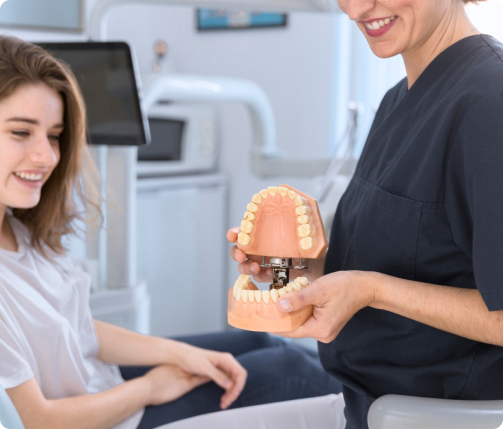DentoClude™ F has Bioactive glass as an active ingredient which is a clinically proven and well accepted oral tissue regenerative material. Bioactive glass has the ability to bond to hard and soft tissues without rejection. They are osteoinductive, stimulate the proliferation of bone cells, and are totally resorbable. The particle size of bioactive glass in DentoClude™ F being less than 1micron aids in coating the dental implant surfaces that promotes remineralization to create stronger post implants, etc. Additionally, DentoClude™ F formulation is comprised of botanical excipients to prevent anti-inflammation/ infections.

DentoClude™ F is a bioactive glass comprising SiO2, Na2O, CaO, P2O5, Fluoride, Neem and Dadima. Once in contact with the body fluids, Bioactive glasses immediately undergo ionic dissolution and bioactive glass degradation via the exchange of H+ ions in the solution and Na+ and Ca2+ from the glass network. The ion exchange results in the formation of silanol groups (Si–O–H) due to the hydrolysis of the silica groups. An increased alkaline local environment develops due to the increase in OH- concentration. The silica network is further degraded as the pH rises, forming orthosilicic acid and Si (OH)4 on the surface in the form of a negatively charged gel. The gel layer functions as a matrix for hydroxyapatite with precipitation sites. Beneath the gel layer is a depleted alkaline surface layer on top of the bulk glass. On top of the gel layer, a layer of amorphous calcium phosphate forms. Precipitation and further mineralization occur due to the incorporated carbonate ions from the now supersaturated solution, thus the concentration of Ca- and Si-ions in solution are critical. The newly formed hydroxyapatite enables growth factors to adsorb to the surface, as well as attachment, proliferation, and differentiation of osteoprogenitor cells by cytokines and extracellular matrix components expressed by the upregulation of several genes. Collagen and glycoproteins are believed to incorporate the surrounding bone tissue into the hydroxyapatite layer. As the hydroxyapatite grows inwards, the Bioactive glass starts to resorb and gets replaced by growing bone tissue. Osteoclasts, once incorporated in the growing bone, break down larger particles resulting in a more extended period of resorption and stronger bone.
Furthermore, presence of Neem and Dadima in DentoClude™ F makes it unique as both of them are being used in ayurveda since time immemorial in various oral health issues because of their anti-inflammatory, anti-bacterial and anti-pyrogenic properties.
At DentoClude™ F, we innovate dental solutions to enhance patient care. Our flagship product, DentoClude™ F, offers cutting-edge technology for effective tooth sensitivity relief.
© 2024, DentoClude™ F, All Rights Reserved, Powered by Kerlotech.